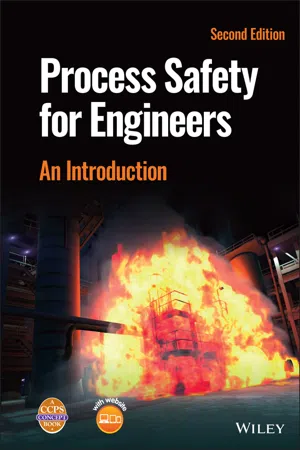
- English
- ePUB (mobile friendly)
- Available on iOS & Android
About this book
Process Safety for Engineers
Familiarizes an engineer new to process safety with the concept of process safety management
In this significantly revised second edition of Process Safety for Engineers: An Introduction, CCPS delivers a comprehensive book showing how Process Safety concepts are used to reduce operational risks. Students, new engineers, and others new to process safety will benefit from this book.
In this updated edition, each chapter begins with a detailed incident case study, provides steps that help address issues, and contains problem sets which can be assigned to students.
The second edition covers:
- Process Safety: including an overview of CCPS' Risk Based Process Safety
- Hazards: specifically fire and explosion, reactive chemical, and toxicity
- Design considerations for hazard control: including Hazard Identification and Risk Analysis
- Management of operational risk: including management of change
In addition, the book presents how Process Safety performance is monitored and sustained. The associated online resources are linked to the latest online CCPS resources and lectures.
Frequently asked questions
- Essential is ideal for learners and professionals who enjoy exploring a wide range of subjects. Access the Essential Library with 800,000+ trusted titles and best-sellers across business, personal growth, and the humanities. Includes unlimited reading time and Standard Read Aloud voice.
- Complete: Perfect for advanced learners and researchers needing full, unrestricted access. Unlock 1.4M+ books across hundreds of subjects, including academic and specialized titles. The Complete Plan also includes advanced features like Premium Read Aloud and Research Assistant.
Please note we cannot support devices running on iOS 13 and Android 7 or earlier. Learn more about using the app.
Information
1
Introduction and Regulatory Overview
1.1 Purpose of this Book
- State the importance of process safety as illustrated by process safety incidents,
- Use common process safety definitions and terminology,
- Summarize Risk Based Process Safety (RBPS) as defined by the CCPS,
- Participate in and contribute to basic hazard identification and risk analysis,
- Locate basic process safety information, resources, and tools,
- Apply process safety concepts to design and operation of engineered systems, and
- Contribute, in a supporting role, to the management of process safety hazards and risks.
1.2 Target Audience
1.3 Process Safety – What Is It?
| Process Safety ‐ A disciplined framework for managing the integrity of operating systems and processes handling hazardous substances by applying good design principles, engineering, and operating practices. Note: Process safety focuses on efforts to reduce process safety risks associated with processes handling hazardous materials and energies. Process safety efforts help reduce the frequency and consequences of potential incidents. These incidents include toxic or flammable material releases (loss events), resulting in toxic effects, fires, or explosions. The incident impact includes harm to people (injuries, fatalities), harm to the environment, property damage, production losses, and adverse business publicity. (CCPS Glossary) |  |
“Process safety hazards can give rise to major accidents involving the release of potentially dangerous materials, the release of energy (such as fires and explosions), or both. Process safety incidents can have catastrophic effects and can result in multiple injuries and fatalities, as well as substantial economic, property, and environmental damage. Process safety refinery incidents can affect workers inside the refinery and members of the public who reside nearby. Process safety in a refinery involves the prevention of leaks, spills, equipment malfunctions, over‐pressures, excessive temperatures, corrosion, metal fatigue, and other similar conditions. Process safety programs focus on the design and engineering of facilities, hazard assessments, management of change, inspection, testing, and maintenance of equipment, effective alarms, effective process control, procedures, training of personnel, and human factors.” (CSB 2007)
1.4 Process Safety, Occupational Safety, and Environmental Impact
Table of contents
- Cover
- Table of Contents
- Title Page
- Copyright
- Dedication
- List of Figures
- List of Tables
- Acronyms and Abbreviations
- Glossary
- Acknowledgements
- Online Materials Accompanying This Book
- Preface
- 1 Introduction and Regulatory Overview
- 2 Risk Based Process Safety
- 3 Process Safety Regulations, Codes, and Standards
- 4 Fire and Explosion Hazards
- 5 Reactive Chemical Hazards
- 6 Toxic Hazards
- 7 Chemical Hazards Data Sources
- 8 Other Hazards
- 9 Process Safety Incident Classification
- 10 Project Design Basics
- 11 Equipment Failure
- 12 Hazard Identification
- 13 Consequence Analysis
- 14 Risk Assessment
- 15 Risk Mitigation
- 16 Human Factors
- 17 Operational Readiness
- 18 Management of Change
- 19 Operating Procedures, Safe Work Practices, Conduct of Operations, and Operational Discipline
- 20 Emergency Management
- 21 People Management Aspects of Process Safety Management
- 22 Sustaining Process Safety Performance
- 23 Process Safety Culture
- Appendix A – Concluding Exercises
- Appendix B – Relationship Between Book Content and Typical Engineering Courses
- Appendix C – Example RAGAGEP List
- Appendix D – Reactive Chemicals Checklist
- Appendix E – Classifying Process Safety Events Using API RP 754 3nd Edition
- Appendix F – Example Process Operations Readings and Evaluations
- Appendix G – List of CSB Videos
- Appendix H – Major Process Safety Incident Vs Root Cause Map
- Index
- Wiley End User License Agreement